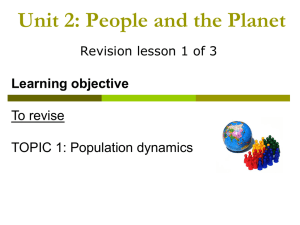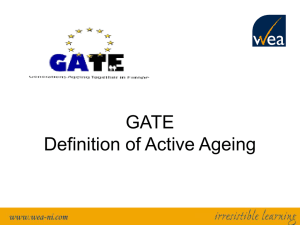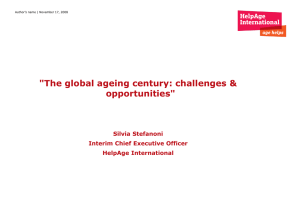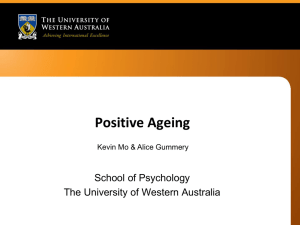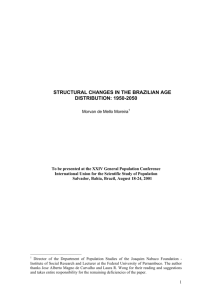Dr. Jennifer Rouse - UWI St. Augustine
advertisement
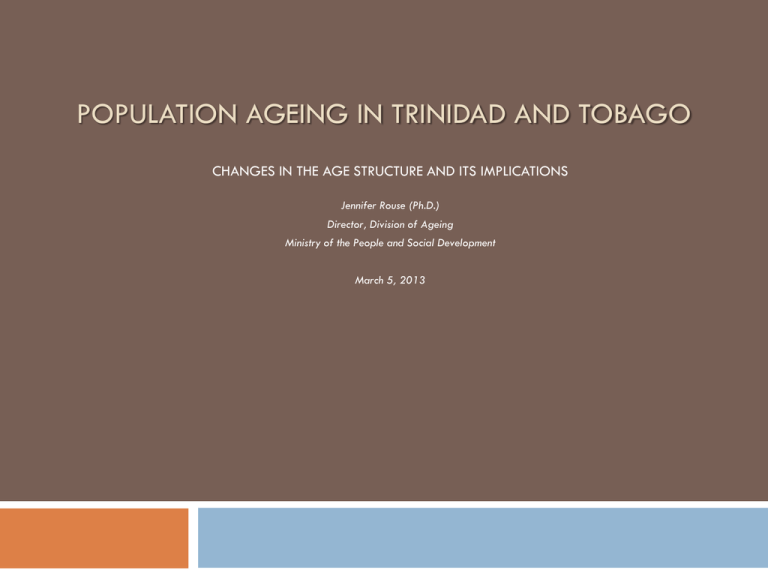
POPULATION AGEING IN TRINIDAD AND TOBAGO CHANGES IN THE AGE STRUCTURE AND ITS IMPLICATIONS Jennifer Rouse (Ph.D.) Director, Division of Ageing Ministry of the People and Social Development March 5, 2013 Introduction T&T’s older persons (i.e., aged 60 yrs and over) represent 12% or 156,000 of the total population, of which 9% are over 65 yrs (CSO, 2011) The elderly population is projected to be 17.7% in 2025 and expected to increase to 30.1% in 2050 Economic indicators reveal that institutional arrangements in the region are untenable to bear this exponential growth rate of seniors A proactive approach is needed to address the challenge of population ageing Dynamics of Population Ageing The Potential Support Ratio (PSR) Number of persons aged15-64 yrs able to support a person aged 65+ Caribbean PSR ratio: 10:1. Expected decrease: 3:1 by 2050 1/3 of all Caribbean elderly receive government support The Dependency Ratio Number of persons under 15 & over 65 per 100 persons 15-64 yrs Dependency Ratio assumes dependency on working age population T&T Dependency Ratio : 9.7 and expected to increase to 44.4 by 2050 Caribbean Dependency Ratio: 10 & expected to increase to 31 in 2050 The Parent Support Ratio (PSRi) Ratio of persons 85 yrs and over to every 100 persons aged 50-64yrs Current PSRi 4.8 and expected to increase to 19.3 persons by 2050 Informal community-based support and family network as primary forms of care in the Caribbean Dynamics of Population Ageing (cont’d) Loneliness Loneliness a major issue for elderly in T&T 33% of surveyed group (n=845) felt lonely, despite only 16% living alone (Rawlins, 2008) Old-age depression linked to loneliness Life expectancy Avg. in 2009 is 74.8 yrs & projected increase is 80.5 in 2050 Caribbean avg. is 75.5yrs & projected increase is 77.6 in 2050 Increased demand for gender-based healthcare and geriatric services “Feminization of poverty” as avg. life expectancy for women is 81 yrs compared to 78 yrs for men Dynamics of Population Ageing (cont’d) Labour Force Participation Male participation exceeds female participation Illiteracy rates much higher among women Women overrepresented in the informal sector and few employed in the formal sector Women most likely to be left out of pension schemes Women more dependent on men and a smaller informal network 41% of women name the family as an important source of income Ageism and mandatory retirement age of 60-65 yrs fosters social exclusion THE FIRST WORLD RESPONSE The United States Low fertility & high life expectancy combine for slow growth rate 17.9% of Americans are elderly persons (UN, 2009) 2.7% annual elderly growth rate exceeds total population growth rate 1% ‘Baby boomer’ generation to severely affect PSR due retirement in 2011 PSR to decrease to 3.4% in 2025 and 2.9% in 2050 Growing fiscal gap due to low PSR will affect Social Security support “Oldest-old” 38% and growing at fastest rate (long-term care increase) 7.7% of GDP is spent on pensions in developed countries & 15% by 2050 Approx. 25% of GDP will be spent on pension and healthcare by 2050 First World Response (cont’d) United Nations Vienna International Plan of Action on Ageing (1982) Governments of developed countries to take primary responsibility for ageing initiatives Madrid International Plan of Action On Ageing (2002) Specific focus on developing countries Growing areas of concern: HIV/AIDS; violence and abuse; access to health services; and social protection Challenges faced in T&T Income and Social Security Two pension systems – a contributory National Insurance Scheme (NIS) and non-contributory for monthly-paid public sector workers Informal sector workers (patronage) and self-employed are excluded from NIS and reliant on Senior Citizens Pension at 65yrs Administrative problems arise from the operation of both schemes such as inadequate funding; delays between application and payment; resistance to change to direct deposit Challenges faced in T&T (cont’d) Health Protection A change in demand that requires new services and treatments Region’s shortcomings in terms of equal access to healthcare; lack of human and financial resources; problems of articulation between various levels of the healthcare system and the public and private sectors Increased need for primary healthcare A dearth of care-giving services for the elderly Inadequacy of elderly care institutions Challenges faced in T&T (cont’d) Socio-Economic A shortage of housing and the existence of poor living arrangements affecting quality of life (multigenerational homes) Disparity between rural and urban needs and responses Financial pressures due to grandparents parenting Impact of HIV/AIDS among females aged 15-45 yrs: in 2005, GDP reduced by 4.2%; savings by 10%; and investment by 15.5% Issues affecting male population aged 15-45yrs – homicide, drug abuse, vehicular accidents, incarceration and social displacement Developments in Policy Income Security Periodic increments to Senior Citizens Pension made by the Government where the minimum quantum was shifted twice in 2010 from $2,500 monthly to $3,000 monthly In 2008 & 2011, an increase in the minimum Social Security to $2,000 and $3,000 per mth respectively Pension in Trinidad and Tobago theoretically falls within a large enough safety net from the poverty line, representing a relatively low level of indigence amongst the elderly Developments in Policy (cont’d) Health and Social Support Networks Chronic Disease Assistance Programme (CDAP) Continuum of Health & Social Support Systems for Older Persons Annual Public Open Forum for Older Persons Commemoration of World Elder Abuse Awareness Day Commemoration of International Day of Older Persons A National Policy on Ageing Legislation on Homes for Older Persons enacted Retirement Programme for Public Officers Geriatric Adolescent Partnership Programme (GAPP) Developments in Policy (cont’d) The Social Welfare Division Public Assistance Food Subsidy Free Bus Passes Free Medical Equipment Burial Assistance Home Improvement Grant Household Items Grant Dietary Grant Homecare Grant Recommendations Developments in Social Security Devise mechanisms to ensure that the dignity of older persons is maintained Developments in Income Security & Employment Ensure collaboration among relevant agencies to bring about sustainable purchasing power and employment options Review the Senior Citizens Bureau Developments in Health Training in Geriatric Care for family members, care providers and healthcare workers & degree programmes for the region Geriatric hospitals and Residential long-term care facilities needed Recommendations (cont’d) Developments in Social Suport Initiatives for older persons to acquire affordable property Trinidad & Tobago Association for Retired Persons’ (TTARP) role to be defined/bolstered National Plan of Action on Ageing Conclusion First World response classifies ageing phenomenon primarily as an economic issue T&T ageing is multi-faceted requiring participatory approach Ageing issues should be integrated into national development plans which are culturally sensitive Continuous review and evaluation of social and legislative policy objectives to incorporate measures outlined in ageing policy



